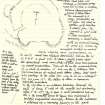Following the launch of trove.scot in February 2025 we are now planning the retiral of some of our webservices. Canmore will be switched off on 24th June 2025. Information about the closure can be found on the HES website: Retiral of HES web services | Historic Environment Scotland
Field Visit
Date 16 August 1943
Event ID 968044
Category Recording
Type Field Visit
Permalink http://canmore.org.uk/event/968044
Castle Spynie occupies the summit of a small high peak on the Aird plateau overlooking the sources of the twin burns that flow out through the common gorge near Milifiach and midway between Crockanord farm and Dun Mor. It thus commands a wide view over the Beauly Firth as well as along the ridge over Dun Mor (q.v.) but is not itself visible from the foot of the ridge being hidden by a lower knoll between two burns. The summit is a crag, precipitous on all sides but clad in patches with heather and small firs. The summit is girt with a drystone rampart forming a small dun with an overall diameter of some 62 ft. Where the rampart rested on naked steeply-sloping rock, particularly on the south, much has slipped downhill, but on the W, N and NE a great pile of stones, visible from afar, is preserved and some strips of outer face have been exposed by casual excavation. These all lie on the circumference of a circle of radius 31 ft, but on the S, between two projecting bosses of naked rock, some stones that look like footings of the other face seem to lie in a straight line for some 16 ft – the status of these is however definitely uncertain.
To the SW there is an entrance passage through the wall 12 ft long 6 ft wide at the mouth but contracting after 3 ft to 3 ft 6 inches. The N face is well preserved but on the S the passage wall seems to have been repaired and perhaps augmented recently. Access to the entrance is obtained up a narrow fissure in the rock opening to the NW, the mouth of which may have been narrowed by an outwork.
The inner face is exposed only at the return of the passage. The interior seems mainly occupied by rock bosses covered with thin heather and fir trees and 6 or more feet higher than the expose outer face of the rampart.
Visited by RCAHMS 16 August 1943
(T D Wallace gives the external diameter as 63 ft and the wall thickness as 14 ft so internal diameter of 36 ft. He suggests comparison with brochs but admits the absence of distinctive features. I agree with him).







